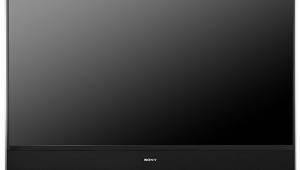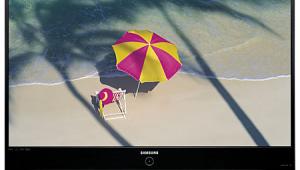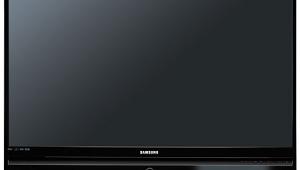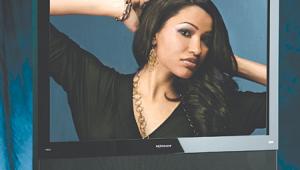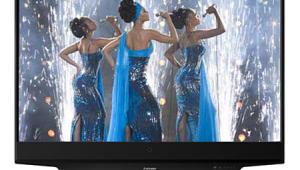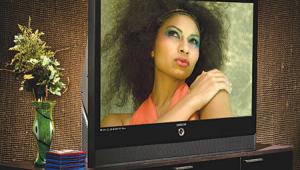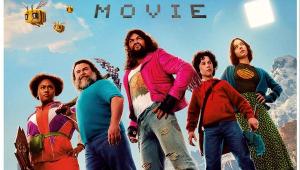Sony BRAVIA KDS-50A3000 SXRD Rear Projection Television Page 2
(Incidentally, according to Sony, the SXRD panel itself doubles the frame rate yet again by flashing each frame it receives from the set's video processing circuits—either original or repeated—twice. But that added detail does not invalidate the explanation here.)
Turn on the Motion Enhancer, however, and the added frames are interpolated from the prior and subsequent frames. There are two active settings of this control: Standard and High.
 The Motion Naturalizer, however, with two settings, works differently. Instead of repeating or interpolating the added frames, it adds either black frames (Mode 1) or darkened but not totally black frames (Mode 2) between the original frames.
The Motion Naturalizer, however, with two settings, works differently. Instead of repeating or interpolating the added frames, it adds either black frames (Mode 1) or darkened but not totally black frames (Mode 2) between the original frames.
You can select both of these motion features together, in which case you'll get a complex combination of the two processes.
In practice, I found that while the Motion Enhancer did smooth the motion somewhat, it produced a very unnatural effect on film-based material by making it look like video. I did not use it.
Motion Naturalizer, on the other hand, smoothed the motion without the "video" look, but significantly reduced image brightness. While the Motion Naturalizer is a clever and occasionally useful feature, I never found it compelling and generally left it off.
The Motion Naturalizer also adds flicker on 24fps sources. You won't see it on all program material, but if it bothers you it can be eliminated either by defeating the feature or by converting the 24fps source to 60fps (and accepting the addition of 60Hz, 3/2 pulldown).
For more on both of these features, see our recent review of the Sony VPL-VW200 projector. In that device, the Motion Enhancer has the same name, but the Motion Naturalizer is called Film Projection.
Performance
Despite its video processing limitations, the Sony produced an exceptionally pleasing picture with high-definition sources. It also performed well with standard definition sources upconverted externally to 1080i or 1080p before being fed into the set.
In fact, as a high-definition display it offers some advantages over competitive flat panels, once you get past its larger physical footprint and lack of that buzz-inducing, on-the-wall vibe.
The KDS-50A3000 is brighter than most plasmas—if you need the extra output—and has better blacks than most LCDs. Its color performance is close to textbook as long as you use the Normal Color Space setting and have it properly calibrated. Flesh tones were always believable, and greens were only occasionally a little overdone.. And size-for-size it's as detailed as all but the best LCDs and plasmas. It also offers a wider range of picture adjustments than most bargain flat panels, some of which are actually useful in getting the best out of the set.
Yes, it does lack the jaw-dropping "wow" factor of the very best plasmas and LCD displays I've tested. But if the Sony's limitations with a 480i or 480p source don't bother you, or you can get around them as mentioned earlier, the KDS-50A3000 is a bargain in today's market.
I recently recorded a high-definition cable broadcast of the Radio City Music Hall Christmas spectacular on my DVR, and it was indeed spectacular on this set—full of vivid Christmas colors, from the 36 bright red jackets and brilliant, pure white trousers in the Rockettes' classic March of the Wooden Soldiers routine to the 72 legs producing wall-to-wall flesh tones in the group's other numbers.
There are two lamp modes, oddly located in the General menu under Power Saving. Power Saving Off provides full lamp brightness, Power Saving On reduces the lamp to a considerably lower setting.
But that's a good thing, since with the lamp on maximum and the iris wide open this is a very bright set—sometimes uncomfortably so (though we've tested some sets that are, inexplicably, even brighter). In the dark or near dark room I typically use for serious viewing and testing, I experimented with a number of iris/lamp/Contrast control settings. While the Middle fixed iris setting worked well in the low lamp mode with a suitable setting of the Contrast control (and you can run it up to maximum without clipping the whites), I ultimately preferred the Auto2 iris setting, Power Save On, and the Contrast control set between 65 and 80.
This setup minimizes power consumption and should maximize lamp life. It also produced good blacks and a respectable peak contrast ratio. While a Contrast setting of 80 will produce the better peak contrast ratio, 65 was still more than sufficient and usually looked better on movies in a darkened room. The image had plenty of snap with this setup without frying my eyeballs, and the image, even on dark scenes, never looked washed-out or grayish.
I rarely noticed the Auto iris functioning, not even on end titles, where the varying brightness levels as the titles scroll over the screen can cruelly unmask the operation of a dynamic iris. I suspect the bright nature of the set's image makes the eye less sensitive here than with a dimmer projector to the shifting iris position, at least in the range of brightness covered by this sort of program material. But apart from scrolling titles, the Auto irises on all the recent Sony front projectors I've reviewed (apart from the new VPL-VW200, ironically the company's most expensive consumer display) have generally been inconspicuous in their operation.)
As noted earlier, the set is at its best with high-definition program material. Pop on a good HD disc or choose a good HD program and the color and natural detail of the Sony were a pleasure to see. Harry Potter and the Goblet of Fire, even panned and scanned to 1.78:1 from its 2.35:1 original on cable, looked crisply defined. And the dark, climactic scenes—particularly when Voldemort and Harry square off in the graveyard—were well handled. The incredible detail of Alexander Revisited: The Final Cut on Blu-ray wasn't shortchanged, either. And even though Hollow Man is probably not listed on Elizabeth Shue or Kevin Bacon's resumes, the transformation scenes, as the big ape and, later, Kevin's character are reduced to progressive invisibility, were ickily detailed on the Sony. Detailed enough, I suspect, to act as anatomically correct, medical training aids.
Black and white films were also pristine. The Sony has good white-field uniformity, apart from the inevitable hot spotting present in most rear projection sets, visible here on test patterns but not obvious on regular program material. Casablanca has probably never looked better than it does on its current HD DVD, and the Sony did nothing to diminish its vividly crisp and clean black and white images.
I did occasionally notice the sparkly texture that characterizes most rear projection sets on bright scenes. An inevitable result of their high gain, freznel/lenticular screens, this artifact bothers some viewers. But I find it easy to ignore.
Image geometry, which can sometimes be a problem with rear projection sets and their complex, mirrored light paths, was good. But there was some misconvergence of red in much of the image, more likely due to chromatic aberration than panel misalignment (since the critical middle third of the image looked fine). But the deviations were limited to a pixel or less in magnitude, and were clearly visible only on test patterns.
Conclusions
Low price? Check. Great color? Check. Solid detail? Check. High brightness but with features equipped to tame it, at least to some degree? Check.
The Sony KDS-50A3000 is not flawless, particularly if you feed it a 480i source, but getting around its limitations is neither difficult nor expensive to do with the quality of the external video processing and upconversion in nearly all of today's source components. There's a lot to like here.
Highlights
• Excellent value
• Strong HD performance for both color and resolution
• Good blacks, particularly with the Auto iris engaged
• Poor 480i-to-1080p video processing



